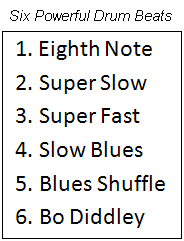
This is the second part of a two part post that introduces 6 of the most important drum beats. If you missed part 1, you can see it here: 6 Simple but Powerful Drum Beats – Part 1
If you know these 6 drum beats, you can play any rock, pop and country song written in the past 50 years. As I mentioned in the Part 1, these beats are easy to learn, easy to remember, and form the basis for learning any song imaginable. Knowing these beats will allow you to get your first drum audition with a band and jump-start your musical career!
If you need to refresh your memory about how to read drum music, visit this post: The Key to Reading Drum Music.
So let’s take a look at beats 4 through 6: Slow Blues, Blues Shuffle and Bo Diddley.
4. The Slow Blues Drum Beat
The blues beats use triplets to give a very different feel to the drum beat. Triplets are groupings of three notes played within one beat and counted “1-and-ah-2-and-ah-3-and-ah-4-and-ah.”
Here’s what a slow blues beat looks like.

Play triplets on the hi-hat with your right hand, the snare drum on 2 & 4, and the bass drum on 1 & 3.
You’ve heard this beat before. It’s played really slowly like on If You Don’t Know Me By Now by Harold Melvin & the Blue Notes. It’s also played at medium tempo like So Far Away by Staind. And it can be played as a faster slow blues (if there is such a thing) like Bad to the Bone by George Thorogood.
5. The Fast Blues Shuffle Drum Beat
You’ll know why this beat is called a shuffle when you hear it. It sounds like someone shuffling along, dragging their heel with each step they take. Or think about what a horse sounds like when it’s galloping across an open field. Ba-dump, ba-dump, ba-dump. That’s the sound of a shuffle.
It’s used mostly when playing blues music so that’s why it’s called “fast blues” or “blues shuffle.” Most drummers just call it a “shuffle.” Here’s what it looks like on paper:

Play a triplet feel with the right hand on the hi-hat, leaving out the middle triplet note. Play 2 & 4 on the snare drum, and quarter notes on the bass drum.
I love to play the song Cold Shot by Stevie Ray Vaughn. His drummer, Chris Layton, plays a variation called the Texas Shuffle where he plays the triplets with his left hand on the snare drum. Every drummer has his favorite way to play a shuffle.
A faster shuffle is the song Higher Ground by Stevie Wonder. If you want to hear a really fast shuffle, listen to Lido Shuffle by Boz Skaggs or The Boys are Back in Town by Thin Lizzy.
6. The Bo Diddley Drum Beat
Bo Diddley was a guitar player in the 1950’s. He popularized the West African 3-2 clave beat (pronounced claw-vay). He used the distinctive rhythm in so many of his songs that it became known as the Bo Diddley beat. The reason it’s called a 3-2 clave is because the beat is made up of 3 long notes, a pause and then 2 short notes.
Of the 6 beats, this one is probably the hardest to play because there are so many notes in fast succession. Once you have the rhythm and get in the groove, the beat almost plays itself.
Here’s the beat:

Sixteenth notes are played on the snare drum, alternating between your hands. Play 2 & 4 with your hi-hat (left foot) and quarter notes on your bass drum.
The Bo Diddley beat has been used for many popular songs like The Who’s Magic Bus, Bow Wow Wow’s I Want Candy and Guns N’ Roses’ Mr. Brownstone. Linkin Park drummer Rob Bourdon plays a variation of the beat on the 2003 hit Numb.
Next Step: Learn the Beats
The next step is to make sure you can play all 6 of these beats at any reasonable tempo. If you can do that, you will be able to play just about any rock, pop or country song written in the last 50 years!
I’m looking forward to the next series of blog posts where we’ll get into the details of playing each beat. We’ll break down each pattern, starting simple with what you already know, and then re-working the notes so you’ll end up feeling confident about playing each beat at any speed.
Once you know these basic beats you can start adding your own variations. You can also start working out fills for each beat to help with song section transitions. You’ll learn to easily apply one of the 6 powerful drum beats to any song your band knows. And you’ll gain the confidence necessary to pass any audition or play any big gig!

you do realize that #5 is just eight notes that are in swing, right??
Thanks for the comment, Jordan. Yes, a shuffle can also be notated as straight eighth notes. But for those drummers who are not familiar with that notation, I wanted to make sure they understood the triplet feel of a shuffle.